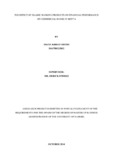| dc.description.abstract | Shariah compliant finance has become an accepted niche product and service in local
financial transactions. It offers a fresh opportunity to emphasize the moral and ethical aspects
of business and finance that reaches beyond the Islamic world to prompt a re-examination of
the core values underlying all financial transactions. In the recent past in Kenya, there has
been a substantial increase in the number of new initiatives to develop and improve the
concept of Islamic financing. The main objective of this study was to investigate the effect of
Islamic banking products on the financial performance of commercial banks in Kenya over a
period of five years (2009 to 2013). Correlation analysis was carried out to investigate the
strength of the relationship between the dependent variable and independent variables.
Multiple regression analysis was carried out to investigate the nature of the relationship
between the dependent and independent variables. Looking at the variables collectively, it’s
evident that there was a strong positive significant relationship between bank performance
and Bank size, Liquidity, Murabaha, Mudaraba and Tawarruq.Although Ijara had a positive
relationship with return on assets it was not significant. From this we can conclude that an
increase in either of the variables of interest is associated with an increase in Islamic bank
performance. The ANOVA shows that the F value of 22.278 & P value <0.05 indicates that
the overall regression model for the control variables is significant hence it has some
explanatory value. Hence, there is a significant relationship between bank size, liquidity and
bank performance. At 95 percent confidence interval i.e. P–value (p<0.05) it implies that both
the control variables combined do influence Islamic banks performance. In addition, an F
value of 16.475 & P value <0.05 indicates that the overall regression model constituting of
both control and predictor variables have an influence on Islamic bank performance. Bank
size is the most influential control variable since it had the most statistically significant
coefficient as indicated by a t ratio of 4.652 and a beta coefficient of 0.346 .Also there is a
significant positive relationship between liquidity ratio and Islamic bank performance as
indicated by (β=6.228, t=3.175 and p value < 0.05). In the full model constituting of
predictors and the control variables Murabaha had the most statistically significant coefficient
as indicated by the t-ratio of 3.461(β=7.20E-10, t=3.461, p value =3.461). It is important to
note that all the available Islamic products available in Kenyan commercial banks had a
positive significant relation with the exclusion of Ijara which had positive insignificant
relationship. This implies that an increase in provision of Islamic banking services in Kenyan
commercial banks will lead to increase in Banks performance. | en_US |

